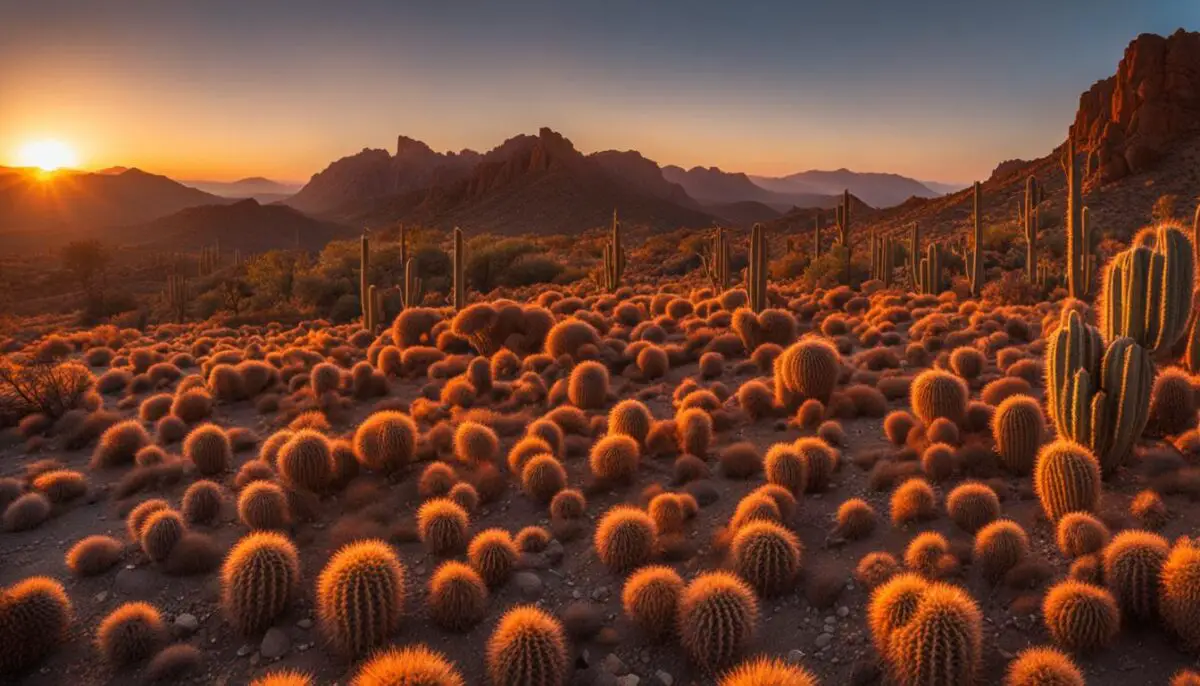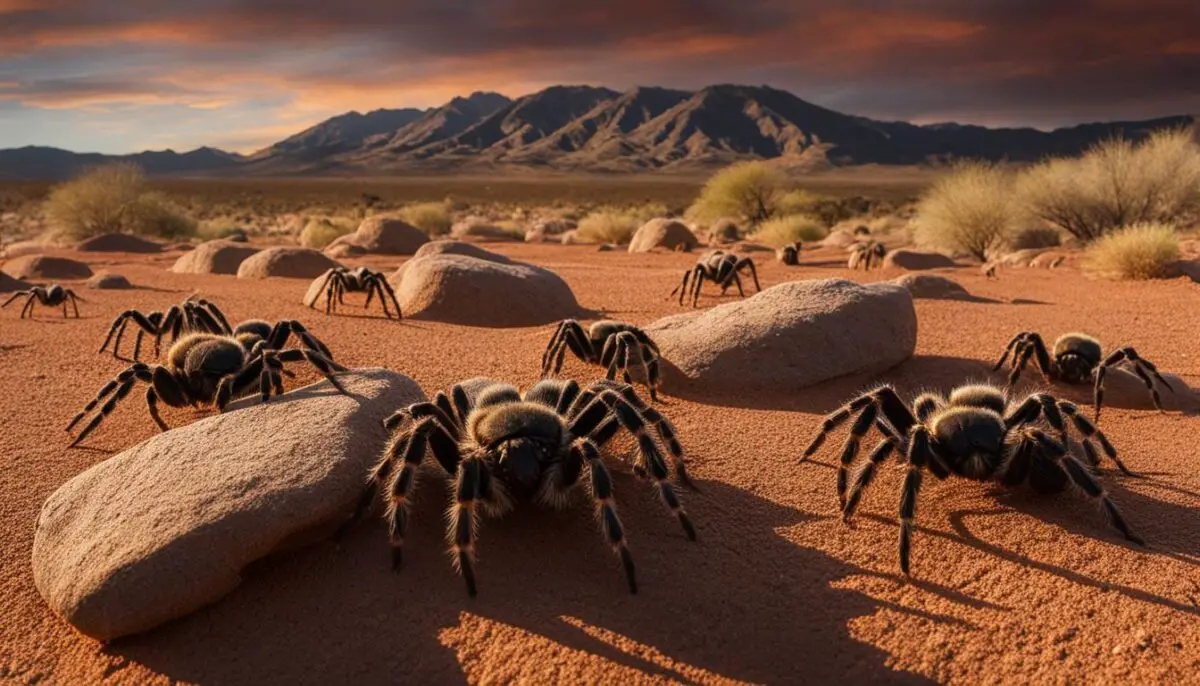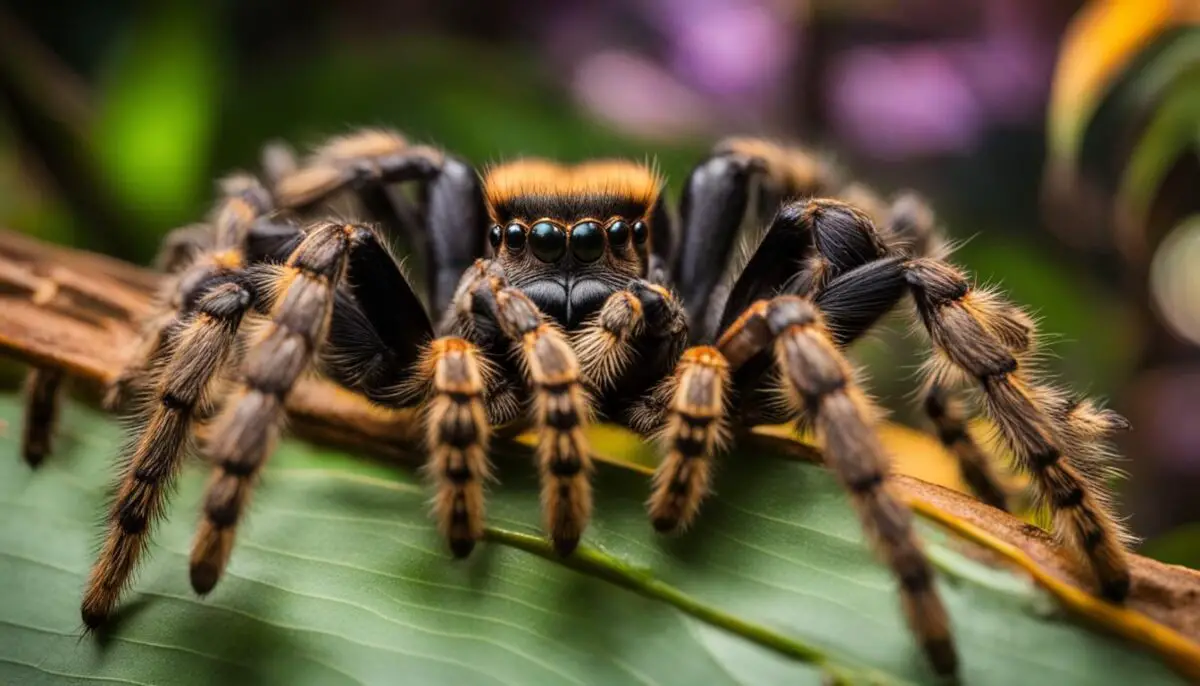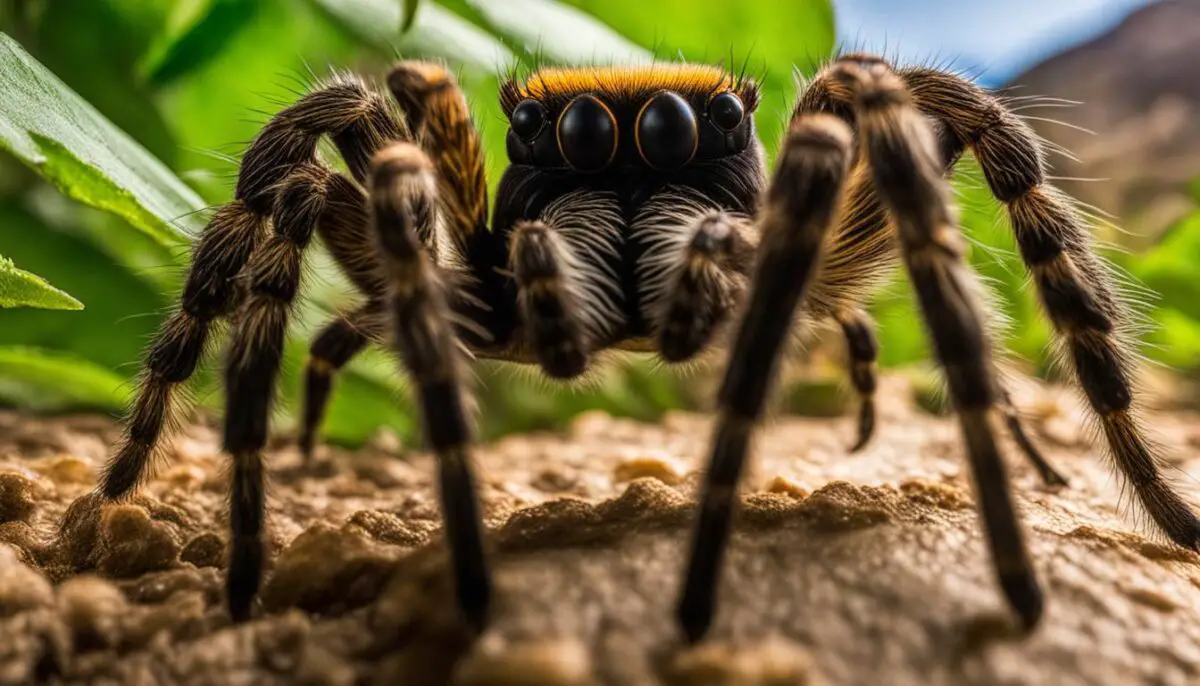Did you know that tarantulas engage in an annual mating ritual called a “mategration”? In this article, we will delve into the fascinating world of tarantula migration patterns, routes, and destinations. Discover the wonders of these arachnids’ journeys as they search for mating opportunities in the La Junta region and southeast Colorado.
During the mating season, male tarantulas embark on an extraordinary journey across the Comanche National Grassland in search of female burrows. Witnessing this unique event can offer a glimpse into the intricate behaviors and survival strategies of these creatures.
Key Takeaways
- Tarantulas engage in an annual mating ritual known as a “mategration.”
- Male tarantulas travel across the Comanche National Grassland in search of mating opportunities.
- The La Junta region in southeast Colorado is a popular location for tarantula viewing.
- Peak viewing times occur in the hour before sunset during September and October.
- Tarantulas mate quickly to avoid being cannibalized by the females.
Where Do Tarantulas Migrate To
The Mating Season and Tarantula Behavior
During the mating season, tarantulas exhibit fascinating behaviors that are essential for their reproductive success. Male tarantulas, after reaching sexual maturity, embark on a nightly journey of 20 to 100 meters in search of female burrows. This behavior allows them to locate potential mates and increase their chances of successful reproduction.
Male tarantulas are driven by their instinct to find a mate before their life cycle comes to an end. This urgency is evident in their behavior, as they carefully navigate their surroundings, sometimes encountering predators along the way. They must also be cautious when approaching female burrows, as females may display aggression or even cannibalize their potential mates. where do tarantulas migrate to
After mating, male tarantulas typically die within a year, making their journey and successful reproduction all the more crucial. This pattern highlights the sacrifice and dedication exhibited by male tarantulas during the mating season.
https://www.youtube.com/watch?v=SOIuBYb65Q8
Interesting Fact:
“Male tarantulas have a limited lifespan after mating, emphasizing the importance of finding a mate during the seasonal window.”
Tarantula Mating Season Highlights:
- Male tarantulas become sexually mature after seven to ten years.
- Females reach reproductive readiness after ten to twelve years.
- The mating season begins in September when temperatures cool at night.
- Males embark on nightly journeys of 20 to 100 meters to find female burrows.
- Mating is a quick process to avoid female aggression.
- After mating, male tarantulas typically die within a year.
The mating season of tarantulas provides a captivating glimpse into their unique behavior and instinctual drive to ensure the survival of their species. Understanding their mating habits and the challenges they face during this period is crucial for researchers studying tarantulas and contributes to the broader field of arachnid biology. tarantula migration routes
Tarantula Viewing Tips
When it comes to observing tarantulas during their migration season, there are a few tips that can enhance your viewing experience. Timing is crucial, as the best time to spot these fascinating creatures is approximately an hour before dusk from September to early November, depending on weather conditions. Warm and calm days are ideal for tarantulas to be active and visible. tarantula migration destinations
One recommended location for tarantula viewing is south of La Junta on Highway 109, within the Comanche National Grassland. However, it’s important to pull off the road as far as possible and exercise caution when observing tarantulas, as passing vehicles can be a potential hazard. tarantula species migratory behavior
While observing tarantulas, it’s essential to be aware of their natural predators, such as tarantula hawks. These predatory wasps prey on tarantulas, and their presence can indicate the location of these intriguing creatures. When venturing out to view tarantulas, it’s advisable to bring binoculars or a camera for a closer look without disturbing their natural habitat.
Tarantula Viewing Tips:
- Plan your outing approximately an hour before dusk during September to early November.
- Choose warm and calm days for optimal tarantula activity.
- Visit south of La Junta on Highway 109 for a recommended tarantula viewing location.
- Pull off the road as far as possible and be cautious of passing vehicles.
- Be aware of tarantula hawks, predatory wasps that prey on tarantulas.
- Bring binoculars or a camera for a closer look without disturbing their habitat.
By following these tarantula viewing tips, you can increase your chances of spotting these incredible creatures and gain a deeper appreciation for their migration habits and natural behavior.
Tarantula Migration Destinations and Routes
For those seeking to witness the awe-inspiring migration of tarantulas, several destinations in La Junta and southeast Colorado offer ideal viewing opportunities. These locations provide undisturbed prairies that serve as prime habitats for the tarantulas, making it easier for enthusiasts to observe their intriguing behavior. Some recommended sites for tarantula spotting include Vogel Canyon, Sierra Vista, Timpas, and Delhi near La Junta. tarantula migration facts
Vogel Canyon is a great choice for visitors looking for short hikes and picnic areas while enjoying the tarantula migration spectacle. Sierra Vista, situated along the Santa Fe Trail, offers a scenic hiking trail that allows nature enthusiasts to immerse themselves in the beauty of the surrounding landscape while keeping an eye out for tarantulas. Timpas, located along Highway 350, is known for tarantulas occasionally crossing the road in this area, providing a unique opportunity to witness their migration firsthand. Delhi, too, presents excellent chances for tarantula sightings. tarantula migration habits
To optimize your tarantula viewing experience, consider driving along Highways 10, 350, and 109, as well as the county roads in between, south of La Junta. These routes have proven to be fruitful for spotting tarantulas during their migration season. As you travel through these areas, remain vigilant and cautious of passing vehicles, ensuring your safety while observing these fascinating creatures in their natural habitat.
| Location | Features |
|---|---|
| Vogel Canyon | Short hikes and picnic areas |
| Sierra Vista | Hiking trail along the Santa Fe Trail |
| Timpas | Tarantulas crossing the road |
| Delhi | Opportunities for tarantula sightings |

Note: The table above summarizes the features of each location and provides a quick reference for choosing the most suitable spot for tarantula viewing.
Tarantulas in Southeast Colorado
Southeast Colorado, particularly the La Junta region, is renowned for its significant tarantula population. This area provides undisturbed prairies that serve as ideal habitats for female tarantulas to create their burrows. During the mating season, which occurs from September to early November, tarantulas in this region exhibit fascinating behavior and embark on their annual journey known as a “mategration.” This phenomenon has gained attention and is now considered an ecotourism opportunity, attracting visitors from various locations. tarantula migration season
The tarantula migration patterns observed in Southeast Colorado have sparked interest and led to extensive research. Scientists and enthusiasts study the migration destinations, routes, and patterns of these fascinating arachnids. By understanding their behavior and migrations, researchers can gain valuable insights into the ecological significance of tarantulas and their role in maintaining the delicate balance of local ecosystems. tarantula migration research
Tarantula Migration Research
Tarantulas in Southeast Colorado have become the subject of extensive research to better understand their migration habits and patterns. Scientists and researchers employ various methods, including tracking individual tarantulas using GPS technology and observing their behavior in their natural habitat. Through these studies, researchers aim to uncover the factors influencing tarantula migrations, such as climate, food availability, and reproductive processes. This research not only deepens our understanding of tarantulas but also contributes to the preservation of their habitats and the promotion of ecotourism in the region.
| Migratory Behavior | Mating Ritual | Ecological Significance |
|---|---|---|
| Tarantulas embark on annual mategrations in search of mating opportunities. | Male tarantulas journey to female burrows to mate during the mating season. | Tarantulas play a crucial role in maintaining the balance of local ecosystems by acting as predators of insects. |
| The migration patterns of tarantulas in Southeast Colorado have become an ecotourism attraction. | Mating rituals occur from September to early November, attracting visitors interested in observing these unique creatures. | The presence of tarantulas indicates a healthy and diverse ecosystem. |
| Research is ongoing to understand the factors influencing tarantula migrations. | Scientific studies aim to uncover the intricate mating rituals and behaviors of tarantulas. | Preserving tarantula habitats is vital for maintaining the delicate balance in local ecosystems. |
Tarantulas and Ecotourism
Tarantulas in La Junta and southeast Colorado have become a major attraction for ecotourism. Visitors flock to the region to witness the fascinating phenomenon of tarantula mategration and learn more about these unique creatures. The local community in La Junta has embraced this interest by organizing the annual Tarantula Fest, which features a parade, tarantula tours, vendors, and other tarantula-related activities. This event not only showcases the beauty of tarantulas but also provides an economic boost to the area.
With the growing popularity of tarantula viewing, the Comanche National Grassland has seen increased traffic during the mating season. Tourists and nature enthusiasts gather in popular spots, such as the areas south of La Junta on Highway 109, to catch a glimpse of these fascinating arachnids. The tarantulas’ intricate mating behaviors and the chance to witness their migration patterns have made them a captivating subject for tourists and researchers alike.
Public engagement and support are crucial for the conservation of tarantulas and their ecosystems. By fostering an understanding of tarantulas’ important role in the local ecosystem, visitors are more likely to appreciate and support efforts to protect their habitats. The ecotourism industry surrounding tarantula viewing not only brings economic benefits to the community but also raises awareness about the significance of tarantulas and the need for their conservation.
| Benefits of Tarantula Ecotourism | Importance of Conservation |
|---|---|
| Boosts local economy | Preserves delicate ecosystems |
| Raises awareness about tarantulas | Supports research on tarantula behavior |
| Encourages public engagement | Fosters appreciation for biodiversity |
By promoting sustainable tourism practices and educating the public about tarantulas, we can ensure the long-term survival of these remarkable creatures. The tarantula migration phenomenon serves as a reminder of the interconnectedness of species and the importance of protecting our natural world. So, if you’re looking for an unforgettable and educational experience, consider joining the tarantula enthusiasts in La Junta and southeast Colorado during the mating season.

Tarantula Ecotourism Quotes:
“Witnessing the tarantula mategration was a once-in-a-lifetime experience. It’s incredible how these creatures embark on such a journey in search of their mates. It’s a testament to the wonders of nature.” – Mary Thompson, a tourist from Texas
“Tarantula ecotourism has not only brought economic benefits to our town but also created a stronger sense of community. The Tarantula Fest has become a cherished tradition that brings people together to celebrate these fascinating creatures.” – Mayor John Anderson, La Junta
Understanding Tarantula Behavior and Survival Tactics
Tarantulas are fascinating creatures with unique behavior and survival tactics that enable them to thrive in their natural habitats. To understand these remarkable spiders better, researchers have been studying their migration habits, mating rituals, and interactions with their environment. Through extensive research, valuable insights have been gained into the ways tarantulas navigate their surroundings, secure their food sources, and protect themselves from predators.
One of the key aspects of tarantula behavior is their feeding habits. Tarantulas primarily prey on beetles, grasshoppers, crickets, and other small insects. They use their strong and venomous fangs to immobilize and consume their prey. These feeding habits demonstrate the crucial role tarantulas play as predators in maintaining the ecological balance within their ecosystems.
Survival tactics employed by tarantulas are essential for their protection against potential threats. While coyotes, foxes, snakes, birds, and other predators pose a danger to tarantulas, they have developed several defense mechanisms to increase their chances of survival. For instance, tarantulas can flick their urticating hairs, which are barbed and capable of causing irritation and discomfort to potential attackers. Additionally, some tarantulas exhibit defensive behaviors such as rearing up on their hind legs, hissing, or drumming their legs against the ground to deter predators.
| Tarantula Behavior | Survival Tactics |
|---|---|
| Feeding on beetles, grasshoppers, crickets, and small insects | Flicking urticating hairs, defensive postures |
| Migration habits during mating season | Camouflage, burrowing, avoiding predators |
| Mating rituals to ensure reproductive success | Quick mating process, avoiding cannibalism by females |
Migrations during the mating season also play a significant role in tarantula behavior. Male tarantulas embark on journeys in search of female burrows, often covering distances of 20 to 100 meters each evening. During these migrations, tarantulas utilize their natural camouflage and burrowing abilities to protect themselves from potential predators. These migration behaviors are essential for tarantulas to find suitable mates and ensure their reproductive success.
Overall, understanding the behavior and survival tactics of tarantulas is crucial for their conservation and the preservation of their ecosystems. Further research into their migration habits, mating rituals, and interactions with their environment will contribute to our knowledge of these fascinating creatures and aid in their protection. By raising awareness about the importance of tarantulas and their unique qualities, we can foster a greater appreciation for these creatures and work towards their long-term conservation.
Tarantulas at Butterfly Pavilion
If you’re unable to witness the tarantula migration in person, don’t worry! You can still get up close and personal with these fascinating creatures at the Butterfly Pavilion in Colorado. The Pavilion is home to approximately 500 tarantulas, offering visitors a unique opportunity to observe them as part of their Spiders Around the World exhibition.

At the Butterfly Pavilion, you can not only view the tarantulas but also learn about their importance in ecosystems. The exhibition aims to raise awareness about tarantulas and promote research and conservation efforts. One of the resident tarantulas, named Rosie, even allows visitors to hold her, providing a hands-on experience that deepens understanding and appreciation for these incredible creatures.
Testimonials
“Visiting the tarantula exhibit at the Butterfly Pavilion was a thrilling experience! Seeing these magnificent creatures up close made me appreciate their beauty and unique characteristics. The knowledgeable staff at the Pavilion also helped answer my questions and taught me more about the importance of tarantulas in nature.” – Sarah D.
“As someone who is fascinated by spiders, the tarantula exhibit at the Butterfly Pavilion was a dream come true. It was incredible to see such a diverse collection of tarantulas from around the world. The Pavilion’s commitment to education and conservation is inspiring, and I left with a newfound appreciation for these misunderstood creatures.” – Mark R.
Whether you’re a tarantula enthusiast or simply curious about these marvelous arachnids, the Butterfly Pavilion offers a unique opportunity to learn, observe, and engage with tarantulas in a safe and educational environment.
Tips for Tarantula Viewing
To make the most of your tarantula viewing experience, keep these tips in mind:
Plan Your Outings
Timing is crucial when it comes to spotting tarantulas. They are most active during the hour before sunset. Choose less populated areas with undisturbed prairies, such as the Comanche National Grassland in La Junta, for higher chances of observation.
Observe From a Distance
Tarantulas are generally slow-moving and docile. While they may appear harmless, it’s important not to handle them. Tarantulas have urticating hairs on their bodies that can cause skin irritation. Maintain a respectful distance and avoid any physical contact.
Enjoy the Natural Behavior
Instead of focusing on large numbers of tarantulas, appreciate the opportunity to observe their unique mating rituals during the migration season. Take in their slow movements and study their interactions. Witnessing these natural behaviors is what makes tarantula viewing truly remarkable.
Remember, tarantulas play an important role in the ecosystem as predators of insects. By respecting their natural habitat and engaging in responsible viewing, we can contribute to their conservation and better understand the marvels of tarantula migrations.

Importance of Public Engagement
Public awareness and engagement are crucial for the success of tarantula conservation efforts. Encouraging local communities, visitors, and tourists to appreciate the value of tarantulas in the ecosystem can foster support for their protection. By raising awareness about tarantula migration and their habitats, we can inspire individuals to actively participate in conservation activities and contribute to research initiatives.
Education programs, guided tours, and community events centered around tarantulas can help people understand the significance of these creatures and the need to preserve their habitats. By promoting public interest and involvement, we can ensure a sustainable future for tarantulas and their ecosystems.
Conservation Challenges
While efforts are being made to protect tarantula habitats, several challenges persist. Habitat loss due to urbanization, agricultural practices, and climate change poses a significant threat to tarantula populations. It is important to address these challenges through sustainable land management practices, conservation legislation, and habitat restoration initiatives.
Collaboration between scientists, conservationists, policymakers, and local communities is essential to develop effective conservation strategies. By working together, we can create a future where tarantulas continue to thrive, enriching our ecosystems and captivating our imaginations.
Conclusion
The annual tarantula mating season in La Junta and southeast Colorado is not just a migration, but rather a captivating mating ritual that has gained significant attention. This phenomenon has become a popular ecotourism attraction, allowing visitors to witness the unique behaviors and survival tactics of these fascinating creatures.
Tarantulas play a vital role in the local ecosystems, contributing to the delicate balance by preying on insects and fulfilling their ecological responsibilities. Preserving their habitats, such as the undisturbed prairies found in the Comanche National Grassland, is crucial for their survival and the overall health of the ecosystem.
Continued research, conservation efforts, and public engagement are essential for raising awareness about tarantulas and their migrations. Understanding tarantula migration patterns, discovering new facts, and identifying key destinations can help unlock the mysteries surrounding these intriguing creatures and ensure their long-term protection.
FAQ
What is the annual mating ritual of tarantulas called?
The annual mating ritual of tarantulas is known as a “mategration” rather than a migration.
Where do male tarantulas travel to during the mating season?
Male tarantulas in La Junta and southeast Colorado travel across the Comanche National Grassland in search of mating opportunities.
When is the best time to view tarantulas?
The best time to view tarantulas is one hour before dusk during September to early November, depending on the weather.
What are some popular locations for tarantula viewing?
Some recommended locations for spotting tarantulas include Vogel Canyon, Sierra Vista, Timpas, and Delhi near La Junta.
How long does it take for male tarantulas to become sexually mature?
Male tarantulas become sexually mature after seven to ten years.
What should viewers be cautious of while observing tarantulas?
Viewers should be cautious of passing vehicles and pull off the road as far as possible while observing tarantulas.
What are some predators of tarantulas?
Predators of tarantulas include coyotes, foxes, snakes, birds, and tarantula hawks.
How many tarantulas do visitors typically see during tarantula viewing?
Visitors should be satisfied with seeing a few tarantulas rather than expecting large numbers.
What economic benefits does tarantula viewing bring to local communities?
Tarantula viewing brings economic benefits to local communities, such as La Junta, through increased tourism.
Where can visitors see tarantulas up close if they are unable to visit the migration sites?
Visitors can see tarantulas up close at the Butterfly Pavilion in Colorado, which houses around 500 tarantulas.
Are tarantulas dangerous to humans?
Tarantulas are generally slow-moving and docile but should not be handled, as their urticating hairs can cause skin irritation.
How can public engagement contribute to tarantula conservation efforts?
Public engagement can contribute to tarantula conservation efforts by raising awareness and supporting research on tarantulas and their ecosystems.
What are the survival strategies of tarantulas during winter and the spring flood season?
The survival strategies of tarantulas during winter and the spring flood season are still being studied.

